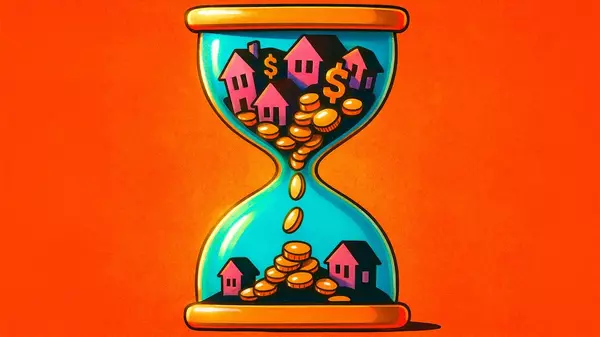Fed Cuts Interest Rate Again as Layoffs Mount: What It Means for Mortgages as Markets React

The Federal Reserve has announced its second interest rate cut in a row, easing monetary policy as concerns grow about rising layoffs and economic fallout from the government shutdown.
Fed Chair Jerome Powell joined the 10-2 majority on the Federal Open Market Committee (FOMC) to vote for the quarter-point rate cut at Wednesday's meeting in Washington, DC.
Dissenting were Trump-appointed Fed Gov. Stephen Miran, who voted for a larger half-point cut, and Kansas City Federal Reserve Bank President Jeffrey Schmid, who voted to leave the policy rate unchanged.
The rare double dissent on opposing sides of the majority consensus highlights the widening divisions on the FOMC, where Powell acknowledges there are "strongly differing views" on the correct path forward.
Wednesday's decision takes the Fed's overnight rate down to a range of 3.75% to 4%, marking the second consecutive cut since September and taking the federal funds rate to its lowest since late 2022.
Wednesday's quarter-point cut was widely anticipated and already largely priced into mortgage rates, which have fallen in recent months and reached a one-year low of 6.19% last week, according to Freddie Mac.
"Mortgage rates moved down notably in advance of the Fed’s meeting, hitting their lowest level in more than a year, but further declines will depend on new developments," says Realtor.com® Chief Economist Danielle Hale. "Today’s dissenting votes show that the Fed is unlikely to see a majority support faster rate cuts absent a more substantial slowdown in economic activity."

In other words, the Fed's latest rate cut doesn't mean mortgage rates will automatically fall further.
Powell's comments at a press conference after the meeting may actually send mortgage rates higher in the short term, as he threw cold water on expectations for further cuts this year.
Highlighting the deep divisions among policymakers during this week's closed-door deliberations, Powell said, "there were strongly differing views about how to proceed in December.
“A further reduction in the policy rate at the December meeting is not a foregone conclusion. Far from it," he said.
Stock markets reacted with dismay, with the Dow Jones Industrial Average turning from gains to losses, dropping as much as 150 points as Powell spoke.
The 10-year Treasury yield, a key benchmark for mortgage rates, surged as much as 7 basis points, driving back above 4%.
That will put upward pressure on mortgage rates in the coming days, reducing the chances of further easing following the Fed announcement.
"The Fed’s decisions are anticipated by the market, which means that the latest rate cut and several more over the next few months are already largely priced in," says Hale. "This means that mortgage rates are not likely to move too much lower from their current position, just above 6%, absent surprisingly slower economic activity."
The Fed does not set mortgage rates directly, and instead sets the short-term rate for overnight lending between commercial banks. Still, expectations about future Fed policy and general financial conditions can influence long-term rates, including mortgage rates.

The Fed uses higher interest rates to combat inflation, and lower interest rates to stimulate the labor market, in line with its dual mandate of price stability and maximum employment.
The two sides of that mandate have been in increasing tension in recent months, with inflation ticking higher as well as signs of weakness in the labor market, presenting Fed policymakers with a challenging dilemma.
But after years of focusing on reining in inflation, Fed policymakers have increasingly shifted their focus to the labor market in recent months, after a series of jobs reports that indicated softening conditions.
"There is no risk-free path for policy as we navigate this tension between our employment and inflation goals," Powell said on Wednesday, calling it a "challenging situation."
Layoffs mount as shutdown cuts off key labor market data
In recent days, a number of major employers announced significant layoffs that could heighten the risk of elevated unemployment, potentially bolstering the case for further Fed rate cuts.
Just this week, Amazon announced the layoff of 14,000 corporate employees as the company shifts resources to invest in AI, while UPS confirmed that it expects to cut 48,000 jobs by the end of this year.
Target also sent roughly 1,000 layoff notices to corporate staff, in a bid to boost profits after years of stagnant sales, and media giant Paramount initiated staffing cuts also close to 1,000.
Powell says that the FOMC is tracking news about the layoffs closely, and watching for any implications about the impact of AI and automation on job creation.
"You see a significant number of companies either announcing that they are not going to be doing much hiring or actually doing layoffs, and much of the time they're talking about AI and what it can do. So we're watching that very carefully," he said at Wednesday's press conference.
Meanwhile, vital federal reports on job growth and unemployment claims are suspended during the government shutdown, making the true scope and scale of the recent layoff headlines difficult to assess.
Although there are private data sources that track employment, they are considered more limited and less reliable than the official government reports, leaving Fed policymakers partly blinded.
"We're going to collect every scrap of data we can find, evaluate it, and think carefully about it," Powell said on Wednesday. "It's many, many different sources ... and it doesn't replace the government data, but it gives us a picture."
Next FOMC meeting set for December
The FOMC will next meet to set interest rate policy on Dec. 9 and 10, with a decision announced on the second day of the meeting.
Miran, the recent Trump appointee who voted for the larger half-point cut on Wednesday, has publicly indicated that he is likely to call for another jumbo cut in December.
But with the panel so deeply divided, it seems unlikely that his view will win over the majority, unless stark economic developments raise the risk of a recession.
As well, if the government shutdown continues, the absence of federal economic data will present a new challenge to Fed policymakers.
"I’d look for the Fed to remain cautious moving forward as, cross their fingers, that more timely data arrives before December," says Realtor.com senior economist Jake Krimmel. "Powell mentioned two risks: inflation to the upside, labor to the downside. But there's now a third: getting out over their skis in the absence of reliable data."
Financial markets currently estimate an 84% probability that the Fed will cut its benchmark rate by another quarter point at the December meeting, according to CME FedWatch.
However, Powell hinted that the blackout on federal economic data may bolster the case for pausing rate cuts at the December meeting, if the government shutdown continues.
"If you're driving in the fog, you slow down," he said. "I'm not committing to that. I'm just saying it's certainly a possibility that you would say: 'We really can't see. So let's, let's slow down.'"
Categories
Recent Posts









"My job is to find and attract mastery-based agents to the office, protect the culture, and make sure everyone is happy! "
